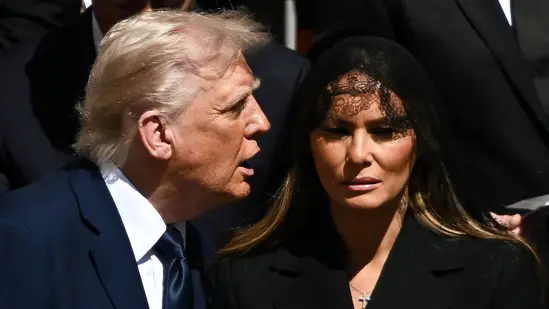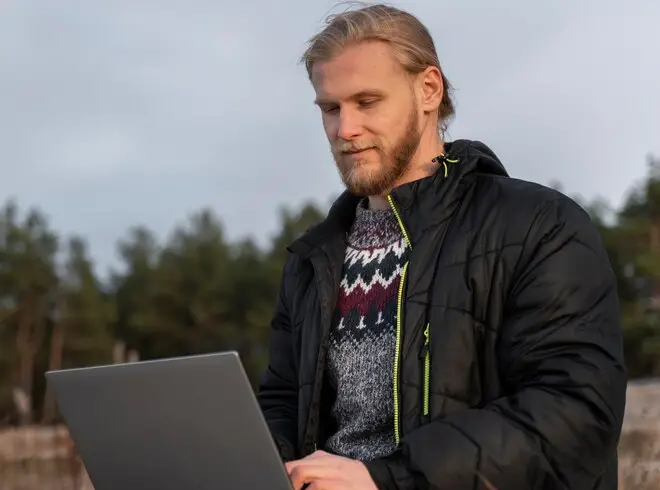On April 26, a historic moment unfolded during Pope Francis’ solemn funeral at St. Peter’s Basilica. As world leaders and dignitaries gathered to mourn the passing of one of the most influential figures in modern Catholicism, a brief and seemingly innocuous interaction between U.S. President Donald Trump and First Lady Melania Trump caught the attention of an observant lip reader. While the global focus was understandably on the high-profile ceremony, the quiet exchange between the couple, deciphered by professional lip reader Nicola Hickling, has added an intriguing layer to an otherwise reverent occasion.
A Moment Amid the Mourning
The event, which saw thousands of mourners pay their respects to the late Pope Francis, was broadcast worldwide, with cameras capturing every gesture, word, and glance. During the two-hour service, an unexpected moment occurred when President Trump leaned toward Melania, whispering a brief seven-word comment. The words, “I’ll go over and speak to him,” caught the attention of Hickling, a forensic lip reader from Lip Reader Limited, who analyzed the footage and provided her interpretation to the Express newspaper.
The whispered remark occurred while the congregation was standing during the service, and although the moment might have seemed insignificant at first, Hickling’s expertise in lip reading provided a glimpse into a private communication between the couple amid a sea of solemn faces. Melania’s response, however, was nonverbal—described as a “side eye” by Hickling. The First Lady’s silence and subtle gesture have only fueled speculation about the nature of the conversation.
As the service unfolded, many wondered who the President might have been referring to with his comment. Was he preparing to speak to a fellow leader? Was it part of a broader diplomatic interaction? The mere suggestion that private exchanges occur between global leaders during such a high-profile event adds a layer of intrigue to the day’s events.
The Presidential Attire: A Departure from Tradition
One aspect of the funeral that didn’t go unnoticed was President Trump’s choice of attire. While funeral protocol typically dictates that attendees wear black to show respect for the deceased, Trump stood out in a vibrant blue suit. This decision garnered attention not only for its contrast with the sea of black-clad mourners but also for its symbolic weight. Critics quickly noted the choice, interpreting it as a statement of individuality in a setting where conformity is expected.
In stark contrast, Melania Trump adhered to the traditional funeral dress code, wearing a classic black blazer, pencil skirt, and a dark lace veil. Her outfit, respectful of Catholic customs, was a nod to her personal religious beliefs as a practicing Roman Catholic. Melania’s attire reflected a sense of decorum and respect for the occasion, serving as a reminder of her deep connection to the Church.
Despite earlier reports suggesting that the Trumps would be seated further from the central action due to Vatican protocol, the couple was positioned near the front, a notable departure from the expected seating arrangement. This prominent placement in televised coverage has further sparked conversations about the nature of their diplomatic standing and the significance of their role at the funeral.
The Unexpected Meeting of Rivals
In addition to the emotional and religious weight of the funeral, the service also served as a backdrop for an impromptu diplomatic meeting between President Trump and Ukrainian President Volodymyr Zelenskyy. The two leaders, who had previously clashed over issues surrounding Ukraine’s conflict with Russia, were seen exchanging words before the service began. Their interaction added a layer of complexity to the funeral proceedings, particularly in light of their past tensions.
Earlier, President Trump had criticized Zelenskyy’s attire during a White House meeting, suggesting that the Ukrainian leader’s military-style dress was inappropriate for the occasion. The exchange was widely covered by the media, with many questioning Trump’s focus on attire rather than the broader geopolitical context. At the papal funeral, however, Zelenskyy appeared in a more conventional black suit, signaling his respect for Catholic funeral traditions. The meeting between the two men marked a subtle diplomatic thaw, albeit one that left many wondering about the true nature of their relationship.
Observers also noted the strategic implications of the encounter, especially given the broader political landscape surrounding U.S.-Ukraine relations. The tensions between the two leaders have been marked by diplomatic complexity, yet the funeral created an opportunity for them to briefly set aside past grievances in a gesture of mutual respect.
Melania’s Catholic Faith and Her Role at the Funeral
While President Trump’s relationship with the Vatican is often framed through the lens of political calculation, Melania’s presence at the funeral had a more personal dimension. As a practicing Roman Catholic, Melania’s attendance signified both her faith and her respect for the late pontiff. She is only the second Catholic First Lady in U.S. history, following Jacqueline Kennedy, and her participation in the service reflected a deep personal connection to the Church.
During her husband’s first term, Melania met Pope Francis in 2017, and the encounter left a lasting impression. At that time, she had presented the Pope with a set of rosary beads for a special blessing, an action that spoke to her devotion. Today’s funeral, in which she adhered to traditional Catholic mourning practices, further cemented her connection to the Church and its values.
President Trump, however, framed his attendance through a more politically oriented lens. In a conversation with Fox News, he remarked that his relationship with Catholics was one of the key reasons for his decision to attend. “I won the Catholic vote,” Trump said, referring to his success in securing a large percentage of Catholic support during his presidential campaigns. His comments were widely interpreted as highlighting the political dimension of his relationship with the Catholic community, which has shaped his approach to issues such as immigration, abortion, and religious freedom.
The Role of Lip Reading in Understanding Diplomatic Moments
The brief exchange between President Trump and Melania brings to light the intriguing role of lip reading in modern diplomacy. As public figures engage in private conversations during highly publicized events, experts like Nicola Hickling provide a unique service by offering insight into the personal interactions that often remain unseen by the public eye.
Lip reading, though an imperfect science, allows experts to decode fleeting moments of communication, shedding light on the relationships and dynamics between leaders. However, the process is not without its limitations. Factors such as camera angles, lighting, and individual speech patterns can all influence the accuracy of a lip reader’s interpretation. While Hickling’s analysis of Trump’s comment—“I’ll go over and speak to him”—has been met with intrigue, the true meaning behind the exchange remains open to interpretation.
The Diplomacy of Funerals: Unspoken Interactions and Global Leadership
Funeral diplomacy, as it is sometimes called, provides a unique environment for leaders to engage in private conversations away from the public eye. These informal exchanges, though often brief and understated, can reveal much about international relations and the personal dynamics between heads of state.
As political leaders gather at significant funerals like that of Pope Francis, the somber occasion allows for moments of genuine human connection, even amidst the usual political tensions. For President Trump and Melania, this event was more than just a ceremonial occasion—it was an opportunity to engage in quiet diplomacy, marked by whispered comments and nonverbal gestures that might otherwise go unnoticed.
As the world continues to process the loss of Pope Francis and the significance of his leadership, the subtleties of diplomatic moments like these offer a fascinating glimpse into the behind-the-scenes interactions that shape global affairs. Whether through private comments or gestures, these moments of connection between world leaders remain an essential part of the complex web of international diplomacy.
In the end, while President Trump’s whispered exchange with Melania may seem trivial, it serves as a reminder of the intricate ways in which personal dynamics, diplomacy, and public perception intersect on the world stage. And, as the Catholic Church transitions into a new chapter with the election of a new pope, these quiet moments of connection will continue to play an important role in the ongoing narrative of global leadership.

